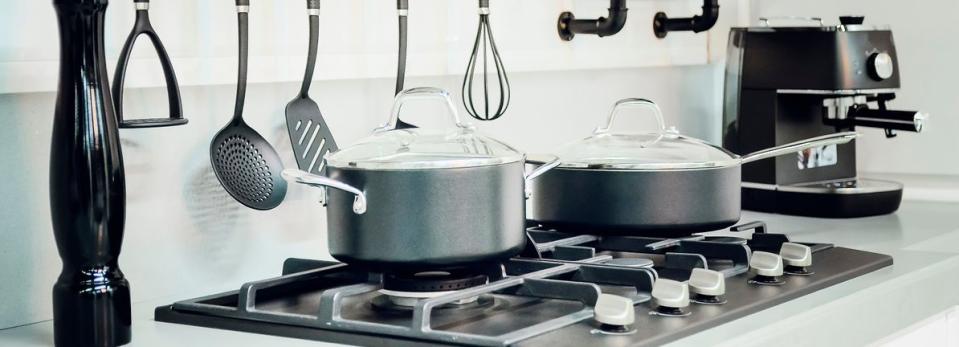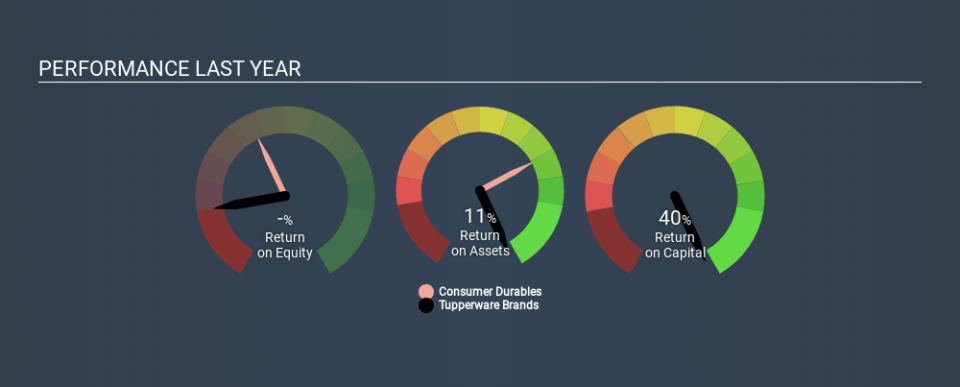Tupperware Brands Corporation (NYSE:TUP) Earns Among The Best Returns In Its Industry

Today we'll look at Tupperware Brands Corporation (NYSE:TUP) and reflect on its potential as an investment. Specifically, we're going to calculate its Return On Capital Employed (ROCE), in the hopes of getting some insight into the business.
Firstly, we'll go over how we calculate ROCE. Next, we'll compare it to others in its industry. Finally, we'll look at how its current liabilities affect its ROCE.
What is Return On Capital Employed (ROCE)?
ROCE is a metric for evaluating how much pre-tax income (in percentage terms) a company earns on the capital invested in its business. All else being equal, a better business will have a higher ROCE. In brief, it is a useful tool, but it is not without drawbacks. Renowned investment researcher Michael Mauboussin has suggested that a high ROCE can indicate that 'one dollar invested in the company generates value of more than one dollar'.
How Do You Calculate Return On Capital Employed?
The formula for calculating the return on capital employed is:
Return on Capital Employed = Earnings Before Interest and Tax (EBIT) ÷ (Total Assets - Current Liabilities)
Or for Tupperware Brands:
0.40 = US$255m ÷ (US$1.3b - US$703m) (Based on the trailing twelve months to September 2019.)
Therefore, Tupperware Brands has an ROCE of 40%.
See our latest analysis for Tupperware Brands
Does Tupperware Brands Have A Good ROCE?
When making comparisons between similar businesses, investors may find ROCE useful. Using our data, we find that Tupperware Brands's ROCE is meaningfully better than the 11% average in the Consumer Durables industry. We would consider this a positive, as it suggests it is using capital more effectively than other similar companies. Regardless of the industry comparison, in absolute terms, Tupperware Brands's ROCE currently appears to be excellent.
We can see that, Tupperware Brands currently has an ROCE of 40% compared to its ROCE 3 years ago, which was 31%. This makes us think about whether the company has been reinvesting shrewdly. You can see in the image below how Tupperware Brands's ROCE compares to its industry. Click to see more on past growth.
When considering ROCE, bear in mind that it reflects the past and does not necessarily predict the future. ROCE can be misleading for companies in cyclical industries, with returns looking impressive during the boom times, but very weak during the busts. This is because ROCE only looks at one year, instead of considering returns across a whole cycle. Future performance is what matters, and you can see analyst predictions in our free report on analyst forecasts for the company.
What Are Current Liabilities, And How Do They Affect Tupperware Brands's ROCE?
Liabilities, such as supplier bills and bank overdrafts, are referred to as current liabilities if they need to be paid within 12 months. Due to the way the ROCE equation works, having large bills due in the near term can make it look as though a company has less capital employed, and thus a higher ROCE than usual. To counter this, investors can check if a company has high current liabilities relative to total assets.
Tupperware Brands has total assets of US$1.3b and current liabilities of US$703m. Therefore its current liabilities are equivalent to approximately 53% of its total assets. Tupperware Brands boasts an attractive ROCE, even after considering the boost from high current liabilities.
What We Can Learn From Tupperware Brands's ROCE
So we would be interested in doing more research here -- there may be an opportunity! There might be better investments than Tupperware Brands out there, but you will have to work hard to find them . These promising businesses with rapidly growing earnings might be right up your alley.
Tupperware Brands is not the only stock that insiders are buying. For those who like to find winning investments this free list of growing companies with recent insider purchasing, could be just the ticket.
If you spot an error that warrants correction, please contact the editor at editorial-team@simplywallst.com. This article by Simply Wall St is general in nature. It does not constitute a recommendation to buy or sell any stock, and does not take account of your objectives, or your financial situation. Simply Wall St has no position in the stocks mentioned.
We aim to bring you long-term focused research analysis driven by fundamental data. Note that our analysis may not factor in the latest price-sensitive company announcements or qualitative material. Thank you for reading.

 Yahoo Finance
Yahoo Finance 
